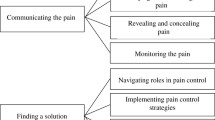Abstract
Goals
Undertreatment of cancer pain remains a major health-care problem. We utilized focus groups of hospice and home-health nurses and patients to elucidate factors contributing to inadequate pain management and to generate solutions for closing the gap between the current reality and optimal pain management.
Patients and methods
Focus groups were conducted among hospice and home-health-care nurses (two groups; n=22) and patients (six groups; n=54) using a standardized question guide. Audiotapes were transcribed and analyzed using NUD*IST software. Themes discovered among patients and nurses were analyzed for similarities and differences.
Main results
Of 22 participants in the two home-health and hospice nurses focus groups, all were white women, the average age was 43 (range 29–64) years, and the average number of years in nursing was 21 (range 8–47) years. Of 54 participants in the six cancer patient focus groups, 80% were women, the average age was 54 (range 25–76) years, and 76% were white. Fifty-four percent of patients reported a history of pain associated with their cancer, and almost 30% had pain that they rated as 8 or higher on the pain scale. Barriers to adequate pain management fell into four categories: fears; attitudes, beliefs, and values; patient and provider behaviors; and structural barriers. Patients and nurses reported similar barriers to pain management; however, patients identified more barriers related to provider behavior and structure of the health care system.
Conclusions
This study identified several barriers to cancer pain control not previously identified in the literature. Strategies to improve cancer pain control are suggested.
Similar content being viewed by others
References
Grossman SA and Sheidler VR (2000) Cancer pain. In: Abeloff MD (ed) Clinical oncology, 2nd edn. Churchill Livingstone, New York, pp 539–553
Levy MH (1996) Pharmacologic treatment of cancer pain. N Engl J Med 335:1124–1132
Cleeland CS, Gonin R, Hatfield AK, et al (1994) Pain and its treatment in outpatients with metastatic cancer. N Engl J Med 330:592–596
Zhukovsky DS, Gorowski E, Hausdorff J, Napolitano B and Lesser M (1995) Unmet analgesic needs in cancer patients. J Pain Symptom Manage 10:113–119
Hollen CD, Hollen CW, and Stolte K (2000) Hospice and hospital oncology unit nurses: A comparative survey of knowledge and attitude about cancer pain. Oncol Nurs Forum 27:1593–1599
McMillan SC, Tittle M, Hagan S, Laughlin J and Tabler RE (2000) Knowledge and attitudes of nurses in veterans hospitals about pain management in patients with cancer. Oncol Nurs Forum 27:1415–1423
Sheidler VR, McGuire DB, Grossman SA and Gilbert MR (1992) Analgesic decision-making skills of nurses. Oncol Nurs Forum 19:1531–1534
Lasch K, Greenhill A, Wilkes G, et al (2002) Why study pain? A qualitative analysis of medical and nursing faculty and students' knowledge of and attitudes to cancer pain management. J Palliat Med 5:57–71
Ferrell BR, McCaffery M and Rhiner M (1992) Pain and addiction: An urgent need for change in nursing education. J Pain Symptom Manage 7:117–124
Grossman SA, Sheidler VR, Swedeen K, Mucenski J and Piantadosi S (1991) Correlation of patient and caregiver ratings of cancer pain. J Pain Symptom Manage 6:53–57
Choiniere M, Melzack R, Girard N, Rondeau J and Paquin MJ (1990) Comparisons between patients' and nurses' assessment of pain and medication efficacy in severe burn injuries. Pain 40:143–152
Ward SE, Goldgerg N, Miller-McCauley V, et al (1993) Patient-related barriers to management of cancer pain. Pain 52:319–324
Ward S and Gatwood J (1994) Concerns about reporting pain and using analgesics. Cancer Nurs 17:200–206
Mercadante S (1999) Costs are a further barrier to cancer pain management. J Pain Symptom Manage 18:3–4
Joranson DE (1994) Are health-care reimbursement policies a barrier to acute and cancer pain management? J Pain Symptom Manage 9:244–253
Acknowledgements
This study was funded by the North Carolina Advisory Committee on Cancer Coordination and Control and the North Carolina Cancer Prevention and Control Branch of the Division of Public Health. The authors would like to acknowledge the contributions of other members of the Cancer Pain Advisory Committee: Joni Berry, Jo Anne Dalton, Dori Greene, John Gyves, Diana Maravich-May, Richard Rauck, Charles Trado, Anne Packett, and Adrienne Wallschleger.
Author information
Authors and Affiliations
Corresponding author
Rights and permissions
About this article
Cite this article
Randall-David, E., Wright, J., Porterfield, D.S. et al. Barriers to cancer pain management: home-health and hospice nurses and patients. Support Care Cancer 11, 660–665 (2003). https://doi.org/10.1007/s00520-003-0497-x
Received:
Accepted:
Published:
Issue Date:
DOI: https://doi.org/10.1007/s00520-003-0497-x



